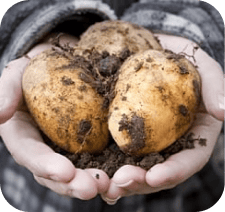Plants are diverse living organisms that can be found from your backyard to all over the world. Archaeologists have even discovered fossils of plants! While some plants produce pretty flowers or delicious fruits or vegetables, other types of plants serve as food for animals or even as their shelter. Today some plant experts suggest that there are some 315,000 different varieties of plants! While these different types of plants vary dramatically in appearance and location, many of them contain the same basic plant parts.
Grow on a strong foundation. We stock everything you need: potting soils to get your seeds started and plant supports for securing vines and vegetables, sprayers for applying compost teas and garden tools for making short work of those big jobs.
Grounded in Plant Roots
Arguably the most important of the plant, even though we rarely see them, a plant’s roots or “root system” do so many different important jobs for the plant. The roots anchor the plant into the ground and transport water and vitamins from the soil that the plant needs to grow and develop. The root system also stores important nutrients when there may not be nutrients (like during the winter) to keep the plant alive and healthy. If plants were unable to store nutrients for future use they wouldn’t be able to live nearly as long.
Stems: The Plant’s Trunk
The plant’s stem is like it’s backbone: the stem provides overall structure and support to the plant, and it is essential to a plant’s growth. Plant stems are what transport water and nutrients the root system gathers from the soil throughout the plant through the leaves, flower and fruit. Depending on the type of plant, stems can vary dramatically, from the thin and flexible stems of a dandelion flower to the sturdy, rigid stem (trunk) of a tree.
Leaf it up to Leaves
If plants didn’t have leaves they wouldn’t be able to live! Leaves absorb sunlight and convert it to energy through a process called photosynthesis. Photosynthesis needs a large amount of sunlight, carbon dioxide (what we exhale), water and chlorophyll which is found in the leaves of plants. Photosynthesis happens constantly so the plant has the proper amount of energy and fuel to live.
Flowers: More Than Just Looks
While many people think that the flower takes center stage because of their beauty and smell, flowers do so much more! In most plants, the flower is the reproductive system of the plant. Like other living organisms, flowers contain organs that produce eggs known as ovules and male and female organs. During pollination, ovules are fertilized leading to the growth and development of a fruit.
It’s Fruit!
Like the plant stem, the fruit of a plant looks dramatically different depending on the type of plant. Most of the time, fruit only develops during a specific time in the growing cycle. Some fruits may be soft and edible while others are hard or difficult to eat and some are even poisonous! We might think that plants grow fruit just as food for us to eat, however the true purpose for fruit is to protect the seed or seeds that grow inside.
Seeds: Plant Eggs
Seeds, while we might find them annoying while eating an apple or a peach, serve a purpose: they contain all of the materials needed to grow a new plant! Much as a plant’s other parts look very different from one type of plant to another, so too are the seeds differing in size, shape and complexity. Without seeds the existence of a number of plant species would be threatened. Today, many scientists are focusing their efforts to preserve various seeds of at-risk plants to try to ensure their longevity.
If reading about the anatomy of a plant has planted some deep-rooted interest in learning more, consider the following resources:
The Great Plant Escape – This interactive site explains the different parts of the plant in a mystery-style format and includes case briefings and facts on plants as well.
Growing Plants: A Lesson Plan – Teachers and educators can use this curriculum guide to teach their students about the process of a plant growing from a seed.
Six Plant Parts – This classroom page explains the six main components of plants plus a song about them.
Plant Interactive Fun for Kids! – Check out this page that has a bunch of further resources on everything to do with plants (and they’re all interactive)!
Plant Reproduction – For further information about how plant reproduction happens (in flowering plants) look no further than this page with its labeled diagrams and easy-to-understand descriptions.











